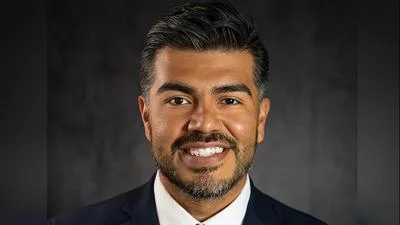State Superintendent Tony Smith wants a $1,500 per household tax increase. | Illinois State Board of Education
State Superintendent Tony Smith wants a $1,500 per household tax increase. | Illinois State Board of Education
Gov. Bruce Rauner's handpicked state schools superintendent is calling for a massive, $7.2 billion tax hike to fund higher school administrator and staff salaries.
The spending increase would require another $1,500 per year from every household in the state if it becomes reality.
Tony Smith, who was hired by Rauner in 2015 and earns $225,000 per year, unveiled his plan at an Illinois State Board of Education board meeting in Chicago last week.
Illinois taxpayers spent about $42 billion on K-12 public schools in 2016; Smith wants to increase that amount to about $50 billion, or just over $27,000 per student.
Smith didn't specify where he expected to get the additional money.
Despite a 32 percent income tax increase last summer, Illinois is on track to have a $3 billion budget shortfall when its fiscal year ends June 30.
Raising another $7.2 billion in income taxes would require an even sharper increase in the state's current rate of 4.95 percent to perhaps as high as 8 or 9 percent.
Smith's request was shocking for the amount and the scant media reaction to it, says one noted economist.
“If (Smith) came out asking for a $1 billion cut in funding, he would get massacred in the press,” Ted Dabrowski, president of WirePoints, told Prairie State Wire. “He's asking for $7 billion more all in one year, and it barely gets a notice.”
Funding "evidence"
The Illinois State Board of Education is proposing that the state increase its share of school funding from the $10.5 billion it spent in 2016-17 to closer to $18 billion.
That's the amount, the board says, it would take for the state to meet its obligations under a new, but discredited, evidence-based funding (EBF) formula that Rauner signed into law last year.
“…it (EBF) was yet another way to avoid actually fixing the problems with education in Illinois,” Dabrowski wrote with policy analyst John Klingner in an article posted on the WirePoints website. “Giving billions more to the state means lawmakers will face far less pressure to consolidate Illinois’ 860 school districts, roll back administrative bloat, or cut executive-level pay.”
As an example, a December story in the Will County Gazette showed that one of the state’s smallest districts, Union School District 81, is also, per student, one of the costliest and worst performing.
The number of students in the district dropped from 113 in 2016 to 104 in 2017. Only 32 percent passed the statewide competency exam, Partnership for Assessment of Readiness for College and Careers, which demonstrates readiness for the next level of education. The district cost taxpayers $28,340 per student last year, the highest-spending district in the state. Yet, Superintendent Timothy Baldermann’s salary has risen dramatically over just a few years: His $207,000 salary last year is nearly double the $127,000 he was hired for in 2012.
What’s more, an earlier Prairie State Wire story shows that evidence-based funding has a dubious track record at best. Eric Hanushek, a senior fellow at the Hoover Institution of Stanford University and an expert in the development of economic analysis of educational issues, said that little evidence exists to support claims of success with an evidence-based school funding system.
“If you listen to the supporters of this system, we should have a bunch of newfound geniuses running around the schools, but achievement has not jumped forward," Hanushek said.
The evidence-based formula was developed by Lawrence Picus of the University of Southern California and Allan Odden of the University of Wisconsin, who since 2000 have conducted school-finance studies in numerous states.
In his article “Confidence Men: Selling Adequacy, Making Millions,” Hanushek said that claims of improvement along the lines of three to six standard deviations would be an “extraordinary gain.” One full standard deviation is approximately equivalent to the average difference in test score performance between a fourth-grader and an eighth-grader.
Rather, Hanushek said the professors and other supporters of the method have selected studies that have in some instances demonstrated improvements in student achievement.
Enrollment up 5 percent, spending up 111 percent
Smith's call for more money comes after two decades of steadily increasing K-12 public school spending in Illinois.
A Prairie State Wire analysis of ISBE spending data found that, between 1998 and 2016, state enrollment in Illinois K-12 public schools rose 4.8 percent, to 1.83 million from 1.75 million. But total taxpayer spending on schools rose 111 percent over the period, in real, inflation-adjusted dollars.
Illinois taxpayers spent $22.9 billion in 1998; they spent $42.4 billion in 2016.
Much of this spending has been borrowed and remains on Illinois' taxpayers' balance sheet.
Over the period analyzed, Illinois' K-12 schools amassed a $71 billion pension debt while running $24.3 billion in operating deficits, meaning they spent more than they were bringing in in tax revenue.
Chicago Public Schools made up $8.3 billion of that total; CPS borrowed to make ends meet in every single year between 1998 and 2016.
Collectively, Illinois' public school system owes more than $90 billion in debt to bondholders and pensioners.
Did the increased spending have an impact?
Illinois' average ACT score in 1998 was 21.4, 2 percent better than the national average (21.0).
In 2016, it was 20.8, or equal to the national average.
-----
How much do Illinois taxpayers spend on K-12 schools each year?
| Year | K-12 Spending | K-12 Enrollment | Per-Pupil Spending |
| 1998 | $22,919,683,579 | 1,753,953 | $13,067 |
| 1999 | $26,008,401,064 | 1,761,834 | $14,762 |
| 2000 | $25,791,900,752 | 1,788,993 | $14,417 |
| 2001 | $30,129,071,644 | 1,805,582 | $16,687 |
| 2002 | $32,640,922,808 | 1,837,863 | $17,760 |
| 2003 | $31,479,080,423 | 1,855,417 | $16,966 |
| 2004 | $22,531,091,600 | 1,862,274 | $12,099 |
| 2005 | $31,800,305,943 | 1,862,046 | $17,078 |
| 2006 | $27,623,252,894 | 1,871,619 | $14,759 |
| 2007 | $30,345,123,053 | 1,881,462 | $16,128 |
| 2008 | $38,200,907,716 | 1,881,810 | $20,300 |
| 2009 | $51,673,756,742 | 1,881,276 | $27,467 |
| 2010 | $26,889,246,200 | 1,887,561 | $14,246 |
| 2011 | $34,753,624,147 | 1,863,017 | $18,654 |
| 2012 | $41,021,176,916 | 1,858,409 | $22,073 |
| 2013 | $36,691,090,164 | 1,866,575 | $19,657 |
| 2014 | $38,776,684,373 | 1,858,766 | $20,862 |
| 2015 | $34,716,971,687 | 1,844,870 | $18,818 |
| 2016 | $42,428,599,216 | 1,838,813 | $23,074 |
Sources: Illinois State Board of Education; Illinois Department of Insurance; Spending totals are inflation-adjusted and include total pension contributions as well as operational costs.






 Alerts Sign-up
Alerts Sign-up